|
Canyon City was the site of an organized settlement during the Klondike Gold Rush. The site's prominence stems from its location at the south end of the Taiya River Canyon (Dyea Canyon). Pre- Klondike Gold RushCamping at this location probably began scores or even hundreds of years before the gold rush. The Tlingit people passed through on their trading expeditions to the Interior. After 1878 use of the trail by white explorers and prospectors began. In June 1883 Lt. Frederick Schwatka established his Camp #3 in this area. William Ogilvie surveyed the area in June 1887. A growing number of prospectors passed through each spring and fall for the next decade. Many bypassed this area in favor of camping at Sheep Camp or Stone House.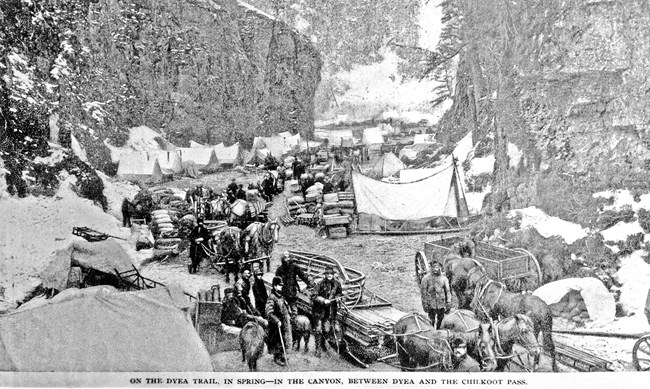
National Park Service, Klondike Gold Rush National Historical Park, George and Edna Rapuzzi Collection, KLGO 55798. Gift of the Rasmuson Foundation. Gold Rush BoomtownWhen the Klondike stampede began, the volume of traffic through the area swelled. Several Klondike-bound parties camped at the mouth of the canyon in the summer and fall of 1897. It is likely that people camped here almost every night during this period. There probably weren't any businesses at the site before winter set in.Canyon City itself sprang into existence in late 1897. Not surprisingly, early growth centered around the area where stampeders crossed the river. During the summer, the townsite was the last level ground before the steep trail overlooking the Taiya River Canyon. Riffles in the river allowed Klondikers to cross here in the summer and fall in relative safety. In the winter, hikers could walk up the frozen riverbed. Though the crossing was less critical, the site was flat ground for camping or the caching of goods. 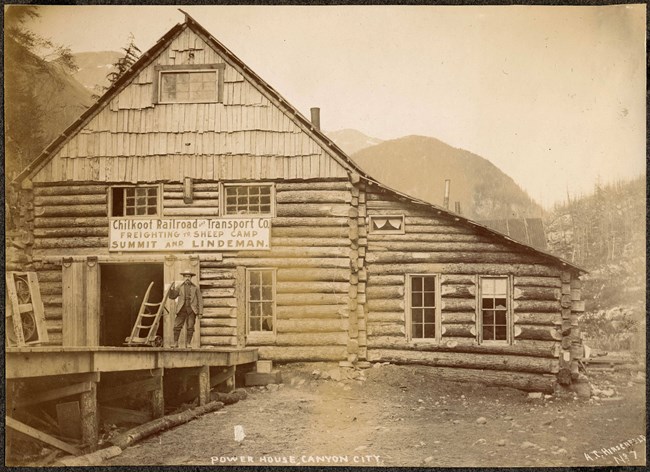
Alaska State Library, William Werner Shorthill Photo Collection. P389-18. The development of tramway systems over the Chilkoot played a major role in creating Canyon City. Two companies located their powerhouses here. The Dyea Klondike Transportation Company (DKT) established its powerhouse on high ground west of the trail. The Chilkoot Railroad and Transport Company (CR&T) established a large plant on the west bank close to the river crossing. 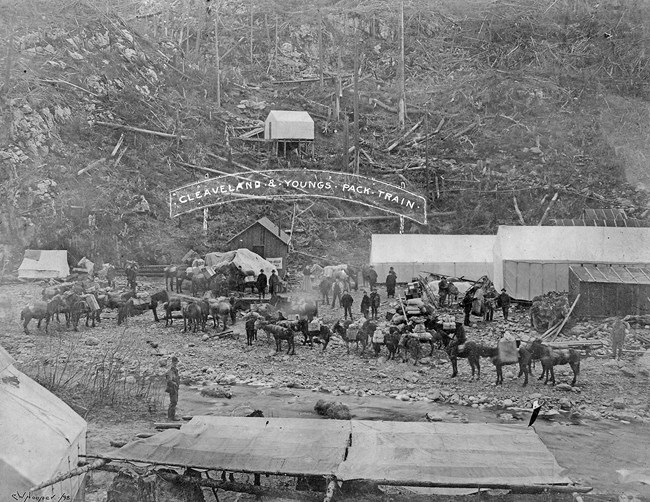
National Park Service, Klondike Gold Rush National Park Service, Candy Waugaman Collection, KLGO Library CC-81-8838. Townsite ImprovementsIn early December 1897 the townsite became a reality partly due to the tramway construction and partly due to the influx of stampeders. First known as Canon Camp, it was later called Canon, Canon City, Canyon, and Canyon City. Growth in the town appears to have begun near the river crossing and extended south. The town was formally organized, complete with a platted system of lots and blocks. Before the end of 1897 several lots were recorded. By mid-December, approximately 150 people were there. At least some of the platted streets were laid out in the cardinal directions. Deed book entries suggest that the plat map contained at least 22 blocks. Unfortunately, a map that delineating those lots and blocks has not survived.To aid tramway construction, work began on an improved wagon road. Work started in December 1897. By January 1898 the Dyea Trail reported that a road was complete all the way to Sheep Camp. In the winter and spring of 1898, Canyon City was the end of the wagon road. In December 1897 the Canyon City townsite contained mostly canvas and wood-braced tents. By the end of January, the Dyea Trail proclaimed that Canyon City was undergoing a small building boom. The town was at its height of activity between February and April 1898. By late February, thirty cabins existed at the site. In March, unimproved lots were being sold for between $200 and $300. The Canyon post office was established May 18, 1898. One source has suggested that the town had a transient population of over five thousand. Photographs and contemporary descriptions suggest that the town never exceeded fifteen hundred people. 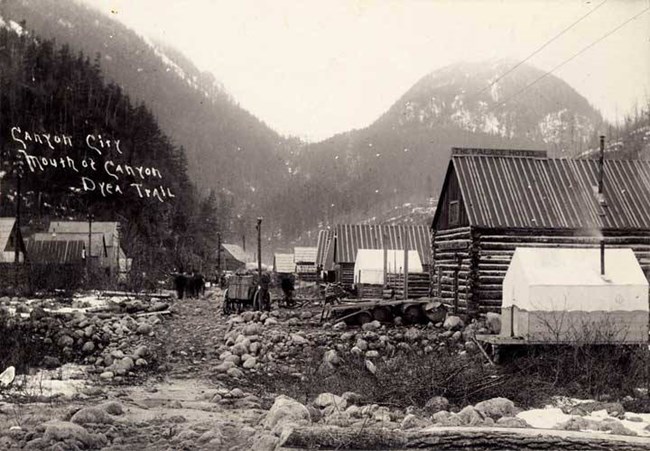
Alaska State Library, Early Prints of Alaska Photo Collection, P297-211.
At least ten other businesses can be seen in historical photographs. However, the signs identifying them cannot be read. At least twenty five wooden business buildings were constructed. Several businesses, both large and small, were set up in wall tents. Canyon City's businesses spread out along either side of the Chilkoot Trail, locally called First Street. A few businesses, primarily those involved in packing and freighting, were located near the river crossing. This northern end of town was between the canyon walls and the river. This area was prone to floods and not suited to the construction of permanent structures. Within the business district, the trail corridor was abnormally wide. This was probably due to the grandiose ideals incorporated into the town plat. 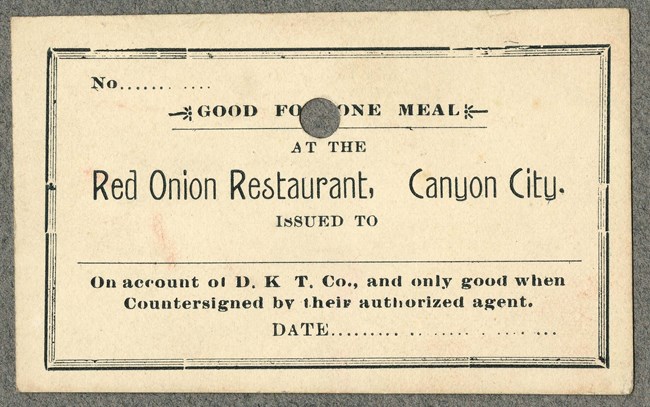
National Park Service, Klondike Gold Rush National Historical Park, George & Edna Rapuzzi Collection, KLGO 55949d. Gift of the Rasmuson Foundation. DeclineAfter the spring flood of stampeders had passed by, Canyon City began to disappear. Within weeks, traffic over the trail slowed to a fraction of what had existed before. Except for the two tramway powerhouses, there was little reason for Canyon City to exist. In July 1898, the DKT Company tramway line merged its operations with the CR&T Company line and shut down. The post office closed on November 18, 1898.William L. Whitaker traveled through Canyon City during the winter of 1898-99. He found the Canyon City Hotel operating, but few other businesses were open. By the time Anton Vogee arrived in July 1899, the CR&T Company tramway had shut down. The only known signs of life were the Canyon City Hotel and the Red Onion Lodging House and Saloon. By March 1900, the majority of the tramway materials had been dismantled and moved to Dyea. The CR&T structures were probably not affected by the dismantling operations. The DKT Company buildings were probably dismantled in early 1900. Workers attempted to remove the large steam boiler, but were unable to move it more than a few feet off its base. You can still see it in that position today. 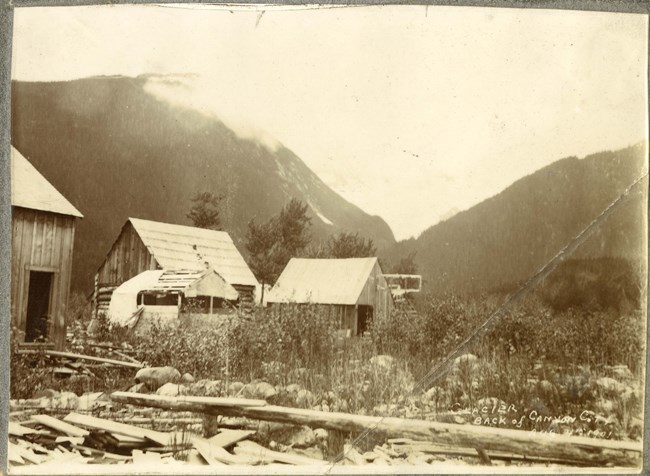
National Park Service, Klondike Gold Rush National Historical Park, George & Edna Rapuzzi Collection, KLGO 55949c. Gift of the Rasmuson Foundation. Over the next half century a large amount of deterioration took place. The large CR&T buildings and the other low lying structures were swept away. The Taiya River has migrated between fifty and one hundred feet west in this area. Periodic floods have invaded Canyon City since the gold rush. At least one recent fire has been recorded. Modern Canyon CityWhen the recreational trail was built in the early 1960s, a spur trail was created here to allow access to the old townsite. By 1968, a bridge spanned the Taiya River in this area. In 1969, a visitor noted "a number of badly deteriorated structures" in the area. As late as 1972 at least one building remained standing. The present swinging bridge replaced the original trail bridge in 1982.The National Park Service conducted an archeological survey of the Canyon City townsite in 1979. Among other projects, they detailed the extent and condition of the Canyon City ruins. The survey identified many cultural remnants. Among them were four structural remains and eighteen foundations. More recently, field surveys have cataloged and photographed hundreds of artifacts at the townsite. The large boiler has been stabilized in place. In 2016 and 2017 the park built a new loop trail to the Canyon City townsite a short distance from the modern Canyon City campground. |
Last updated: July 25, 2024
